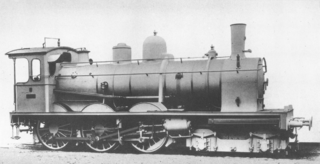
The Royal Bavarian State Railways' sole class S 2/6 steam locomotive was built in 1906 by the firm of Maffei in Munich, Germany. It was of 4-4-4 wheel arrangement in the Whyte notation, or 2'B2' h4v in the UIC classification scheme, and was a 4-cylinder, von Borries, balanced compound locomotive. It was initially assigned No. 3201.
The Royal Bavarian State Railways was the state railway company for the Kingdom of Bavaria. It was founded in 1844. The organisation grew into the second largest of the German state railways with a railway network of 8,526 kilometres by the end of the First World War.

The Class PtL 2/2 locomotives of the Royal Bavarian State Railways were light and very compact superheated steam locomotives for operation on Bavarian branch lines. There were three types in total, of which two were transferred to the Deutsche Reichsbahn-Gesellschaft as Class 98.3 tank locomotives and even survived to join the Deutsche Bundesbahn fleet after the Second World War.

The Class S 3/6 steam locomotives of the Royal Bavarian State Railways were express train locomotives with a 4-6-2 Pacific or 2'C1' wheel arrangement.

The Bavarian Class Gt 2×4/4 engine of the Royal Bavarian State Railways, was a heavy goods train tank locomotive of the Mallet type. It was later designated the DRG Class 96 by the DRG, DB and DR.
The Class B XI engines of the Royal Bavarian State Railways were built between 1895 and 1900 by the firm of Maffei for deployment in Bavaria. The first delivery comprised 39 vehicles with two-cylinder, saturated steam operation, a further 100 two-cylinder compound locomotives followed in the period up to 1900.

The Bavarian G 5/5 goods train, steam locomotives were intended for steep stretches of line belonging to the Royal Bavarian State Railways network in northern Bavaria. The extremely sharp rise in the levels of traffic on these lines in the years leading up to the First World War meant that the eight-coupled Bavarian E I and G 4/5 N classes previously employed there were increasingly unable to cope.
The Bavarian Class G 4/5 N was an early twentieth century German 2-8-0 steam locomotive built for the Royal Bavarian State Railways (K.Bay.Sts.B.). Its design was based on that of the Class E I and it had unmistakable similarities to the final series of that class. Had the K.Bay.Sts.B. not changed their locomotive classification system just before this engine was produced it may well have entered service as the latest variant of E I.

The C IV was a steam locomotive, built for goods train duties, that was manufactured between 1884 and 1897 for the Royal Bavarian State Railways.
The 36 locomotives of Class P 3/5 N of the Royal Bavarian State Railways were built between 1905 and 1907 by Maffei. The P 3/5 N evolved from the S 3/5 express train locomotive and had likewise a four-cylinder compound configuration. Compared with the S 3/5 the P 3/5 N had a smaller boiler but the same size cylinders. The P 3/5 N could haul a 350-ton train at 80 km/h on the level.
The Class S 3/5 engines of the Royal Bavarian State Railways were express train steam locomotives with a 4-6-0 wheel arrangement.
The Class C V of the Royal Bavarian State Railways was one of the first European express train locomotives with a 4-6-0 wheel arrangement.
The Class S 2/5 express locomotives of the Royal Bavarian State Railways were the first steam engines in Germany to be built with full-length bar frames. The prototypes for this type of frame were the two locomotives imported in 1900 from Baldwin Locomotive Works in the US, that had been similarly classified as the S 2/5.
The Bavarian Class E I steam locomotives operated by the Royal Bavarian State Railways encompassed four different variants of saturated steam, goods train locomotive with a 2-8-0 wheel arrangement.

The Prussian G 12 is a 1'E 2-10-0 goods train locomotive built for the Prussian state railways.

The locomotives of Baden Class IV e were designed and built for the Grand Duchy of Baden State Railway in the late 19th century by the Elsässischen Maschinenbau-Gesellschaft Grafenstaden, who supplied the first eight examples in 1894. They were the first locomotives in Germany with a 4-6-0 wheel arrangement. Another 75 locomotives were built up to 1901 by the Maschinenbau-Gesellschaft Karlsruhe.
The Prussian G 5.4 was a German goods train locomotive with a compound engine. Due to its top speed of 65 km/h it was also used on passenger services. The G 5.4, like the G 5.3, differed from the G 5.1 and G 5.2 in having a shorter wheelbase and higher boiler pitch. In addition, the Krauss-Helmholtz bogies enabled its riding qualities to be improved, especially at higher speeds. Between 1901 and 1910 a total of about 760 vehicles of the Class G 5.4 were built for the Prussian state railways. The last 25 locomotives were fitted once again with an Adams axle.
The class IV f locomotives of the Grand Duchy of Baden State Railway were express locomotives with a 4-6-2 (Pacific) wheel arrangement. They later passed to the Deutsche Reichsbahn, who classified them as class 18.2. These were the first Pacific locomotives in Germany and the second in Europe after the Paris-Orléans Railway 4500-series that had appeared a few months earlier.

The Prussian G 7.3 was a class of 2-8-0 locomotives of the Prussian state railways. The third class of the G 7 series, they were intended to power heavy goods trains on steep inclines, on which the permissible axle load was not yet that high. This affected for example, the Paderborn–Holzminden and Betzdorf–Siegen routes.








